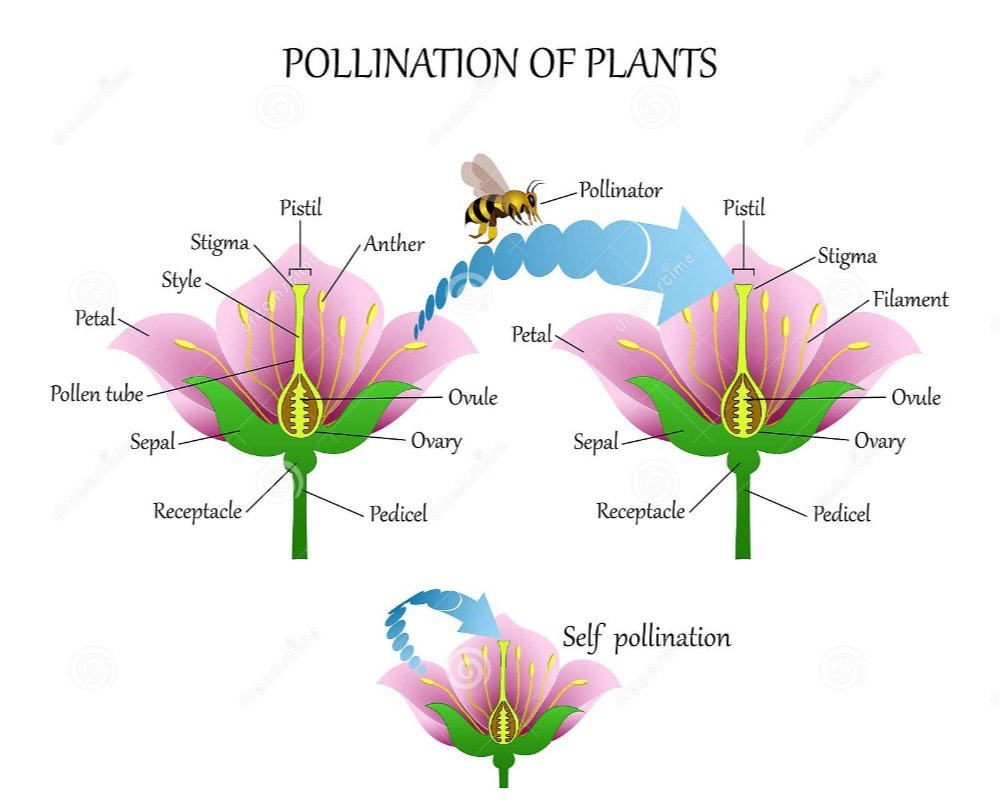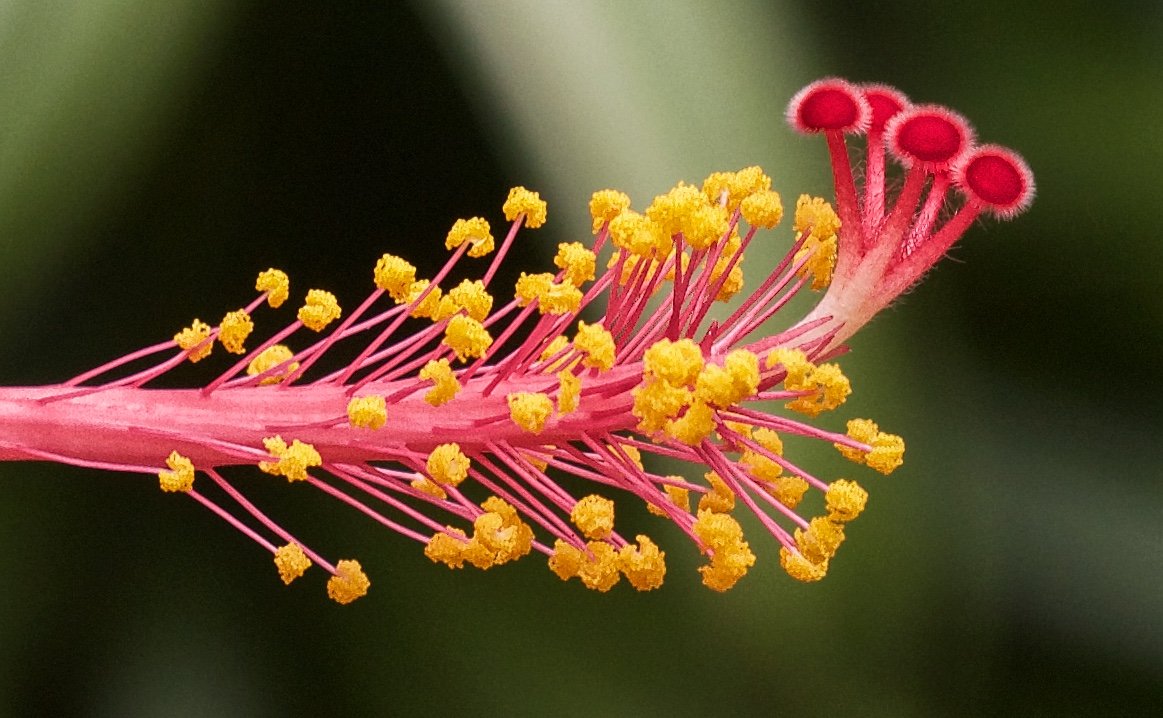I want to design a pollinator garden that is successful and really does add ecosystem services. And I realized that I had a lot to re-learn about botany and plant science to try to understand how pollinators work.
So here goes ... Pollination 101 as looked at through the eyes of a former neurobiologist turned landscape designer and focussing on perennial flowers
In the (too) many years since I took a botany course in college, a lot has changed. Plant science now includes genetic sequencing, genetic engineering, cloning and advanced imaging. The simple steps of sexual reproduction, as seen above, remain the same, but now we can see what the structures actually look like and map the genes controlling the process.
Disclaimer: I’m not an actual botanist. Botanists focus on the pure science of plants. If horticulturists are engineers, botanists are theoretical physicists. They spend a lot of time learning the mechanics of plants and their classification. They are concerned with the theory of plants and how they function. Landscape designers are neither engineers nor theoretical physicists, but it doesn’t hurt to appreciate the value of both and try to keep up with advances made by both.
… Botanist … ….. Horticulturalist … … Designers, but also plantsmen
Living species are designed to ensure the survival of their progeny. If you fail to do that, you become extinct. The most important factors for success of a flowering plant: pollination and seed habit
The reason for pollen
Genetic diversity is required so that in changing environmental or stress conditions some of the progeny can survive. Genetic diversity within and among plant species has developed over millenia in response to growing conditions in natural habitats. Things that count in controlling diversity include geology, soil type, climate, rainfall animal/insect herbivory and plant diseases.
If conditions get too wet, people can pick up and move to higher ground. But plants can't move, so they've made adaptations that allow them to move their progeny (contained within seeds) instead.
sexual reproductive system in flowering plants
Flowers: During the flowering period, male and female flower parts interact in a number of different ways.
The female parts are the gynoecium; male parts are the androecium
The stamen, the male reproductive part of a flower, consists of a long slender stalk, the filament, with a two-lobed anther at the tip. The anther consists of four saclike structures (microsporangia) that produce pollen for pollination.
The number and arrangement of stamens, as well as the way in which the anthers release pollen, are important taxonomic characteristics for many flowering plants. The number of stamens is often the same as the number of petals. Although most flowers contain both male and female structures (perfect flowers), some plants have imperfect (unisexual) flowers. In those, the stamen-containing flowers may be borne individually, as in most squash species, or arranged in long clusters known as catkins, as is characteristic of oaks and willows.
Pollen is contained in bags called pollen sacs which open when the pollen is ripe. Some pollen is only ripe for a few days; some lasts much longer. We think of pollen as yellow powder, but it can be white, orange, brown, purple or black, and it comes in many different shapes and sizes. Botanists are able to identify a plant by the shape of the individual pollen grains!
When pollen grains land on the flower’s stigma, it germinates and forms a pollen tube. The pollen tube grows towards the plant’s ovaries. The pollen tube finds an ovule, bursts, and releases sperm cells. The sperm cells fertilize the ovule and initiate seed formation.
The pollen gets on to the stigma in different ways. Sometimes, it is blown from the stamens of one flower or one plant onto the stamens of another flower. Sometimes, the pollen is carried from flower to flower by insects.
Pollinating insects get dusted with pollen as they brush against the stamens while trying to collect the nectar, and when they visit another flower to drink more nectar, the pollen is deposited on the stigma of the new flower. A flower that is pollinated by the pollen of another flower is cross-pollinated. When the pollen comes from the same flower, the flower is self-pollinated.
Pollen tube formation
Pollen grains will germinate if they are of the same species, and form a specialized structure, the pollen tube, that contains 3 haploid nuclei.
One haploid nucleus directs the operation of growing the pollen tube itself. The other two, the generative nuclei, can be thought of as nonmotile sperm cells. After reaching an ovule and breaking out of the pollen tube tip, one generative nucleus unites with the egg cell to form a diploid zygote (i.e., a fertilized egg with two complete sets of chromosomes, one from each parent). The zygote undergoes a limited number of divisions and gives rise to an embryo. The other generative nucleus fuses with the two polar nuclei in the ovule to produce a triploid (three sets of chromosomes) nucleus, which divides repeatedly before cell-wall formation occurs. This process gives rise to the triploid endosperm, a nutrient tissue that contains a variety of storage materials—such as starch, sugars, fats, proteins, hemicelluloses, and phytate (a phosphate reserve). The endosperm is present during seed development and provides nutrition for the developing embryo and the seedling. .
Fruit
In most cases, the ovary develops into fruit. Fruit consists of fertilized mature ovules (seeds) plus the ovary wall, which may be fleshy (as in an apple) or dry and hard (as in an acorn). In some plants, such as grasses, the outer protective covering of the ovary (the integument) and the ovary wall are completely fused, so seed and fruit form one entity. More often, however, the seeds are discrete units attached to the placenta on the inside of the fruit wall through a stalk.
Simple fruits develop from a single ovary. Simple fruits can be fleshy or they can be dry, with papery or leathery hard walls (poppies, maples, walnuts).
An aggregate fruit develops from a single flower with many ovaries, such as raspberry and blackberry. The flower has one calyx and one corolla but many pistils (ovaries), and each ovary is fertilized separately If some ovules are not pollinated, the fruit will be misshapen.
There are many different subclassifications for fruit
Seeds
A seed contains all of the genetic information needed to develop into an entire plant. Seeds have 3 parts:
The embryo is a miniature plant in an arrested state of development. It will germinate when conditions are favorable, i.e. in response to a number of different cues described below.
The endosperm is a built-in food supply
The seed coat is a hard outer covering that protects the seed from disease and insects. It also prevents water from entering the seed and initiating germination before the proper time.
Seed dispersal: After the seeds ripen, they’re dispersed from the plant in a variety of ways. They land on the ground eventually and can undergo germination if conditions are favorable.
Germination: a seed embryo going from a dormant state to an active, growing state.
Because seeds are reproductive structures and thus important to a species’ survival, plants have evolved many mechanisms to ensure their survival. Most seeds are dormant when they are dispersed.
Dormancy can be broken by scarification: A hard seed coat needs to be damaged to allow water to penetrate. In nature, scarification is done by microbial attack, passage though an animal, freezing and thawing.
Embryo dormancy can be broken by environmental conditions:
a cold period before germinating (may be drawn out over more than one winter)
a combination of moisture and low temperature
a cold - warm - cold cycle (over 2 years)
modest fluctuations in temperatures during the day
light. Some seeds need light to germinate, others are inhibited by light. 20 out of 23 common weed species require light for their seeds to germinate.
Nectar
Butterfly getting nectar from a native lily
To attract pollinating insects, many flowers produce nectar rewards. These flowers may have long tubes, and the insects that pollinate them need long tongues. Larger flowers of this type are sometimes pollinated by humming birds, which also have long tongues. Some flowers are pollinated by moths, and these often have pale colors or perfumes which are stronger at night.
Small secretory structures, called nectaries, are often found at the base of the stamens. Since nectar is the primary reward offered to a potential pollinator, flowers need to ensure that ideally only legitimate pollinators can access the reward (and in that way successfully transfer pollen). So flowers are often “built” around the nectary or the nectar. This is where floral architecture becomes important.
Floral architecture describes and takes into account the relative sizes of floral organs, their degree of fusion and the spatial and functional connections between organs
In the example above:: borage (Borago officinalis) and viper’s bugloss (Echium vulgare) might look completely different at first glance. If you were to focus onlyon the organization of the flowers - breaking their appearance down to the number of organs - you will notice that their floral organization is identical: 5 sepals, 5 petals, 5 stamens, 2 carpels, 1 nectary disk at the base of the ovary. What makes them appear different is, in fact, their floral architecture. Floral architecture is what determines what kinds of pollinators can access the nectar (i.e. do they need long tongues?) and how deeply they need to enter the flower to insert their proboscis into the nectary.
Typical locations of nectaries
Depending on the location of the nectary, the pollinator assists in fertilization and outcrossing of the plant as they brush against the reproductive organs of the plant and pick up or deposit pollen.
Strategies to avoid self-pollinatioN
Cross-pollination is when the sperm cell and the egg cell come from different plants within a given species. It provides plants with genetic diversity. In a changing environmental or stress conditions, such diversity can mean that some of the progeny can survive and the species can continue. If a plant is pollinated from its own flowers or from plants that are genetically identical (clones), genetic diversity is minimized - but there may be other upsides, like you don’t have to expend as much energy making nectar to attract pollinators.
Plants have developed a number of different strategies to avoid self-pollination and maintain diversity.
Strategy: Have the pollen and the ovary mature at different times.
Strategy: Have separate male and female flowers on different parts of the plants
Strategy: Have separate male and female flowers on different plants (dioecious plants)
Strategy: A genetic mechanism called Self-Incompatibility (SI) where “self” pollen tubes are killed in female flowers to prevent fertilization. SI has been reported in more than 100 plant families and occurs in approximately 40% of species including many important crops (e.g., canola, potato, pome and stone fruits, olive, cocoa, tea, coffee, etc.) and/or their wild relatives.
The interesting and easily visible way that coneflowers, which are SI, maximize their chances of getting cross-pollinated.
The flowering head of Echinacea angustifolia is shown above. Florets mature from the bottom of the head to the top in concentric rings daily. A floret that produces an anther one day produces a receptive style the following day that may persist for 10 days until pollinated. Once pollinated, the style will shrivel. This pattern of development is a strategy to overcome SI as well as to deal with pollen insufficiency.
Sterile Plants
Sterile flowers can have abnormal stamens, defective anthers or no viable pollen. Often they’re found to have an incorrect number of chromosomes - called polyploidy. If there is an uneven number of chromosome pairs, the plant can’t produce balanced egg or sperm cells.
Sterile plants can attract a lot of pollinators because they flower for a long time, all the while producing nectar but not seed. Sterile plants can reproduce (or be reproduced) vegetatively but will not be able to produce and disperse their seed.



















